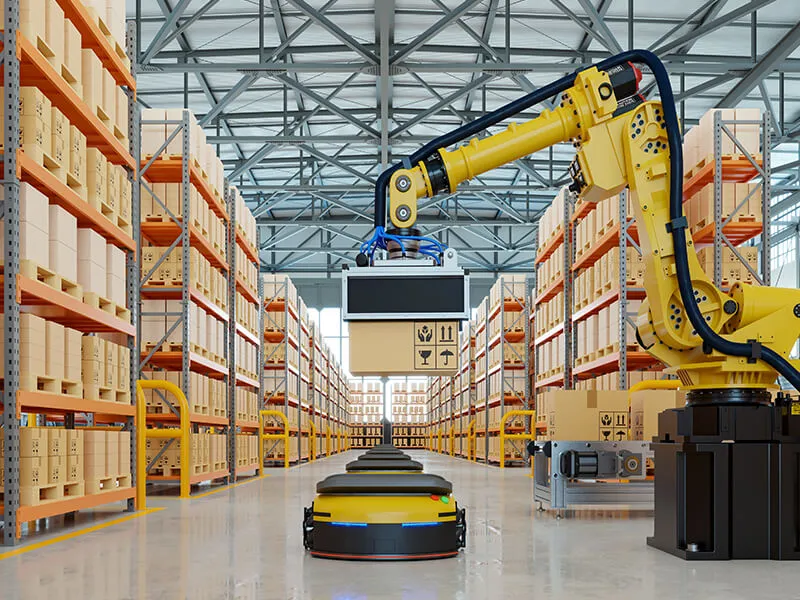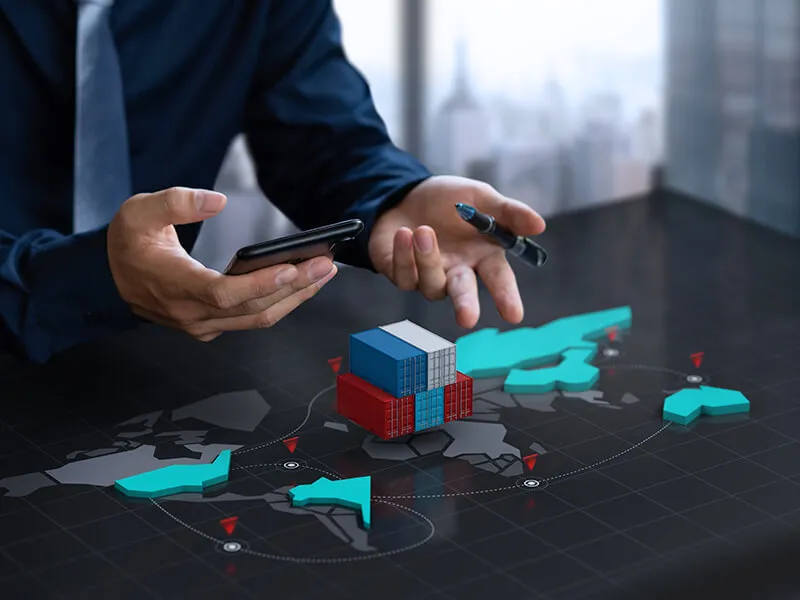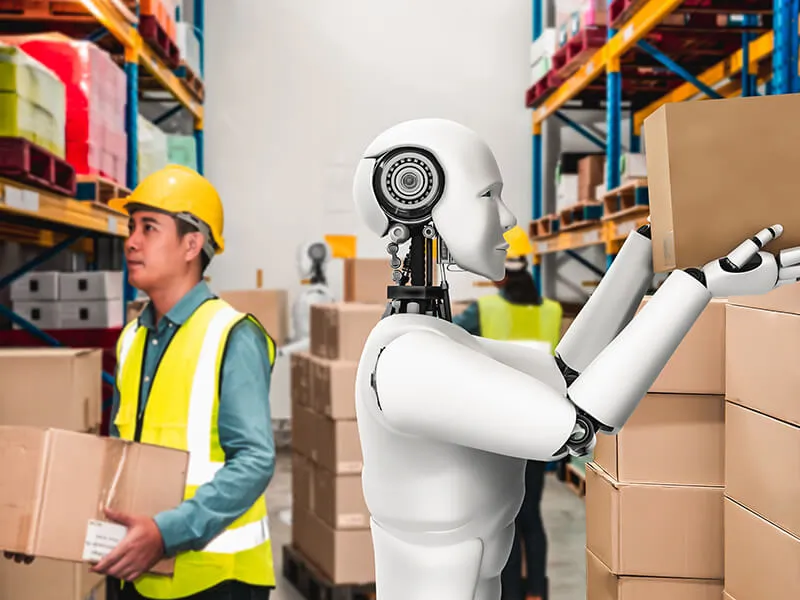The world is headed towards digitization… Each day we see new technologies brimming up, and different domains embracing the same. Yes! The facts speak that the global automation market is all set to reach its peak by the end of 2026 by growing at a CAGR of 3.7% and registering a value of US $136.5 Billion.
When it comes to automation, particularly, the manufacturing and industrial domain have been the top choices with the supply chain being the focus. From CTOs and VPs to Support Engineers and Project Managers, everyone at the top-level management is concerned about inculcating advanced automation in supply chain , given its benefits.
Clearly, when the supply chain is powered by automation, it becomes self-sufficient to attain the autonomous avatar. The next-generation supply chain is seen to be driven by advancements such as Robotics Process Automation (RPA), Autonomous Vehicles, Counterfeit Goods Tracing, and many others.
With the shifting landscapes of technology, conventional supply chain systems have become near to obsolete. The top-level managers are therefore geared up with their own set of expectations with regard to the advanced supply chains. Let us have a look at how and where the expectations from the future of supply chain lies in
-Decision-Making: Pertaining to the market volatility, the majority of enterprises are expecting supply chains to foster real-time decisions that are also precise, quick, and consistent.
-Holistic Adaption: The second expectation that businesses have from supply chains is to constantly adapt to digitalization and technology integration.
-Economical & Social: It is expected that the supply chains would autonomously maintain profit margins and also fulfill social, and environmental goals while meeting the rising market demands.
-Overall Advancement: Substantial amount of growth, rather than only the cost-effectiveness is another expectation demanded by the top-level managers.
-Security Management: Businesses would look after such advanced supply chains to bring in the merits of cybersecurity and risk management.
Let us have a detailed look into how the traditional supply chain is all set to evolve into an autonomous supply chain through advanced automation.
Supply Chain Automation – What’s Transforming, How’s Transforming in 2023?
The sands of the supply chain industry are sifting through tech advancement. And here’s how automation is forming the first step of a more futuristic autonomous supply chain –
1) Automated and Real-time Data Gathering:
Data collection and analysis is a must when it comes to optimizing the supply chain processes. But such a humongous amount of data cannot be fetched manually, hence giving a route for automated collection of real-time business data. This empowers businesses to utilize the available data that might have gone unused in the absence of automation.
So, what’s transforming?
Supply chains would thus witness the transformation in the form of automation, in terms of data gathering, data transmission, data sorting, and data analysis. This would further lead businesses to run quicker and more efficient processes.
How Transformation?
For such transformation, businesses are highly inculcating advanced technologies such as IoT and Big Data that would assist them with cost reduction and customer satisfaction.
2) Automating Process Points in Supply Chain:
Supply Chain is a chain of processes that includes manufacturing, distributing transporting, and selling. Companies dealing in supply chain management can effectively drive the data collected automatically into use, to derive optimum benefits out of it including cost and time efficiency.
What’s transforming?
In supply chain process points, manual and mundane tasks can be easily automated. Digitizing such tasks can free the manpower for other high-priority or essential tasks, while also reducing the chances of error.
Such tasks could be –
- Scanning and analyzing the incoming freight
- Organizing the goods for warehouse storing and packaging
- Drawing out blockages in work processes, among many others.
How Transformation?
Here is how automation in supply chain is being considered for the emerging businesses –
| Aspect | Automation |
|---|---|
| Incoming Freight Scanning | QR Codes, RFID Tags |
| Material/Personnel Shortage Anticipation | Big Data |
| Identification of Underperforming Material Handling Lines, Personnel | Distributed Sensors, Computing |
| Paperwork Generation (Audits, Schedules, Etc) | Automated Back-Office Functions |
3) Storage and Distribution Automation:
Supply chains also face issues relating to the movement of goods within the factory or premise for storage and distribution. The advent of automation in supply chain as inculcated in the warehousing scenarios can solve most of the problems.
What’s transforming?
Such storage and distribution issues within the warehouse facility can be transformed into an efficient system with the help of automated guided vehicles. Such vehicles enable the automatic transportation of goods without any need for manpower across the facility.
How Transformation?
The transformation would take place here with the adoption of Robotic Process Automation(RPA) which would eventually eliminate human interference. Hence, provides ample benefits such as avoiding any accidents, minimizing costs, and saving time.
Apart from these, Last-mile Delivery, Demand Forecasting & Future Planning, as well as Accounts and Back Office Operations process points are also encountered with automation in supply chain management.
Check out the companies that have started their journey of adapting autonomous supply chains
The Ultimate Pathway to the Autonomous Supply Chain

Many supply chain executives see technology as a strategic asset, with developing technologies serving as a tool to handle digitalisation. While executives are primarily concerned with supply chain management, technologies that optimize human reasoning and the use of resources at the edge are also priorities. It’s time that supply chain firms modernize their outdated systems and integrate their technology portfolio!
Intralogistics Smart Robots for Warehousing Operations:
- Intralogistics Smart Robots are here to change the game and meet the needs of process automation in distribution and warehouse centers, given the constantly rising labor rates across the market.
- It is predicted that by the end of 2026, there will be an adoption of smart robots for warehouse operations by 75% of the large-scale enterprise.
- The major benefits that the industries will gain by incorporating supply chain automation are faster implementation and minimal expense.
Embedded Advanced Analytics, AI, and Data Science
- Advanced Analytics(AA) and Artificial Intelligence(AI) are being considered the critical elements for the complete supply chain system across many industries.
- As per the forecast, it is known that more than 75% of commercial SCM app vendors will deploy AA, AI, and Data Science.
- Numerous application vendors who were aware of the importance of AA, AI, and data science have already started embedding these capabilities into their applications.
Rewriting the Base Application to a Microservices Architecture
- With the rise in supply chain complexity and market volatility, there’s a need for supply chain companies to stay more agile, as conventional applications would not be apt for the task in the near time.
- It has been predicted that 25% of supply chain execution vendors will rewrite the core app to a microservices architecture by 2026. While a mere 5% of them would have embraced actual composability.
- Rewriting the core application to a microservices-driven and composable app architecture is the best way to endure the supply chain’s technological base.
Smart Edge Ecosystems
Smart Edge Ecosystems can be understood as physical locations that act as a connection platform for different people, things, and data. For instance, Edge helps connect different machines, operators, devices, and sensors with each other. Hence, activating the system of accurate decision-making in close reference with the sources of information obtained.
The future outlook here seems to have almost 25% of the supply chain decisions made using smart edge ecosystems throughout the year 2025.
It is inevitable for different automated network tools, applications, and devices as well to operate in sync with one another, and Edge ecosystems tend to offer the same. Be it drones, connected vehicles, or even robots, the smart edge ecosystem is the perfect infrastructure. Moreover, advancements occurring in data communication services, whether it be Bluetooth, Wi-Fi, or 5G surely back the edge ecosystems while also supplementing the solutions driven by centralized supply chains.
Digital Supply Chain Twins and Control Towers
Both control towers and digital supply chain twins are key to unlocking the quality insights required for technology investments. These two initiatives, although they are not well-known, are very closely linked and should be combined. If these initiatives are kept apart, companies can experience a significant loss of value due to underperformance or missed opportunities.
Digital supply chain twins solve the problem by enabling end-to-end decision-making. Control towers increase execution visibility and answer resulting queries, such as “What should I do now that this shipment is delayed?”
Keeping the two initiatives separate will not result in peak performance. The digital supply chain twin is too distant (breadth but no depth), which results in lower-quality supply chain optimization. Control towers, on the other hand, are too narrow and do not see the larger picture. They are then focused on solving the lower-quality executions. This again results in underperformance and missed opportunities.
Enter the Realm of Next-gen Businesses with the Automation in Supply Chain!
The Final Approach: Autonomous Supply Chain Management System

Several chief supply chain officers from global supply chain organizations think that the most advanced global supply chains will use hyperautomation, which would be a blend of advanced technologies such as RPA, ML, and more — to become increasingly autonomous over the next ten years.
Hyperautomation necessitates a methodical strategy to swiftly identify, validate, and automate as many business activities as feasible. There are two possibilities –
- There may be a large and costly collection of business procedures that still require humans to execute manual activities and make routine choices across many areas of the end-to-end supply chain.
- The huge and ever-increasing volumes of data generated throughout global supply chains make it hard for people to make rational, fact-based judgments, till the technology augments it.
To experiment, test, and scale-out hyperautomation, chief supply chain officers must develop a multiyear, integrated digital supply chain strategy and plan. Moreover, they may plan their supply chain future in three stages: automation, augmentation, and autonomy.
The route actually starts with Automation in Supply Chain using advanced technologies such as RPA, IoT and Augmented Intelligence. The complete approach revolves around the aspect of how quickly these technologies grow and enter the forefront.
For instance, RPA is likely to become commonplace over the next two to five years. Machine Learning is predicted to become widely used in supply chains during the next five to ten years. This implies that it’s time that you design your machine learning strategy immediately, within the context of your present supply chain strategy planning cycle.
Although it will be a 10-year road, chief supply chain officers should embark on this change today. Technology is rapidly evolving, and there is no point in waiting and just seeing. Chief supply chain officers should constantly strive for greater RPA-based process automation while integrating it with ML to automate more decision-making with higher complexities.
The ultimate goal of this quest might be complete supply chain autonomy. Chief supply chain officers believe that hyperautomation is a chance to unlock people’s time for high-value activities that only humans can undertake.
The human brain’s inventiveness and empathy are difficult to mimic. Chief supply chain officers anticipate that people will be responsible for defining supply chain strategy, pushing innovation, caring for customers, managing data biases, and autonomous decision-making in the future supply chain.
The Next Checkpoint In The Automation Of Supply Chain

Let’s understand the next wave of the market toward the goal of an autonomous supply chain by having a glimpse at the different shifts taking place meanwhile –
#1 The First Paradigm: Remote Work With Human-Centric Work Design
Remote work has now become the new way of living life! With the pandemic that struck the entire globe, people have understood the importance of flexible work arrangements. While technology is playing the lead role in facilitating such an environment, the same could be said in the case of the supply chain industry.
The gist is – what was practiced as location-centric before, during, and after the pandemic has shifted towards being more human-centric. As per the various surveys conducted in recent times regarding the future of the supply chain industry, it has been found that such a market shift would move towards the permanent hybrid working style even on the frontlines.
So what’s the way in? Well, the supply chain experts are working on discovering different techniques that could eventually boost the overall versatility of the industry. They are aiming to inculcate advanced technologies such as AR/VR as it would offer an extended amount of autonomy to the frontline workers in terms of location.
Come and make your mark towards being more human-centric than location-specific by making timely investments in remote work design scenarios.
#2 The Second Paradigm: Real-Time & Insightful Decision-Making
With the rise of pioneering technologies such as 5G, Wi-Fi, IoT, and more, staying and operating in real-time has become the need of the hour. The world is changing rapidly, all thanks to the technological developments around and across the globe. And, such change has also affected the supply chain industry, surely in a positive way.
Demand for the supply chain automation to work in real-time and that too with precise and consistent judgments has been on the rise. This further is giving rise to the demands of real-time datasets and advanced analytics.
As a result, there’s been the advent of a new era of supply chain management systems like smart factories, hyperautomation systems, and more. Such an advancement in supply chain management systems would bring up the chances of supply chains knowing exactly what decision to make and when.
With real-time analytics, companies will have a competitive advantage. That’s why it’s essential to invest wisely in the supply chain management system to get real-time insights. This will overall lead to better workflow and timely decision-making.
#3 The Third Paradigm: Actual Achievement of Social & Environmental Sustainability
Earlier it was the trend that companies stood highly ambitious towards only the action of growth of supply chain business and arising profitability. But nowadays, companies are more focused on achieving environmental sustainability, alongside earning a fair amount of deals.
Apart from environmental sustainability, CEOs are working towards other significant affairs such as diversion, inclusion, equity, and other social responsibilities. One of the reasons to do so is the rising awareness amongst customers regarding the social impact of the products they purchase (how they are made, packaged, transported, etc)
Present-day customers are happy to pay a bit extra for the social or environmental welfare, while they also don’t step back in criticizing and dumping those brands which do not practice such campaigns.
Simply put, this is the right time to park your funds in visible and transparent tools.
#4 The Scenario of Commercial Innovation
The companies are making a huge shift when it comes to catering to their customers. Unlike before when they used to simply focus on the operational part, they are now concerned about commercial innovation as well.
Herein, they take care of the aspects such as the packaging, fulfillment services, and other facilities that the enterprises can offer. One can easily achieve such commercial innovation by gathering and analyzing the data that would further help one know what the end-customer desires.
Presently, it was surveyed and found that less than 50% of the supply chain leaders are investing in such executive roles that stand inevitably to take ahead the commercial innovation. And only 25% of them are inculcating new customer service roles under their organizational setups.

Hence, it is worth it that investments into such advanced supply chain shifts are welcomed for the industry to meet the ever-changing global needs.
Complete autonomy of the supply chain is being predicted as the ultimate checkpoint in this direction. As per the majority of the Chief Supply Chain Officers in the industry, hyperautomation is considered a golden chance for any high-priority or value-added tasks that are sometimes difficult to accomplish through machines and technologies. As per the supply chain professionals, tasks such as strategy defining, inculcating innovations, maintaining customers, monitoring data biases, and likewise will be handled in a much better way by humans.
Does this not explicitly express what the future of the supply chain industry holds within its folds?The Supply Chain Industry is all set to meet the Autonomous Supply Chain in the nearing times. All thanks to the Automation in Supply Chain backed by different pioneering technologies such as AI, IoT, RPA, Human Augmentation, Blockchain, and so much more.


